REVIEW ARTICLE
PACHECO, Fábia Fagundes [1], BARRETO, Jhonata da Silva [2], SILVA, Roseli Barreto da [3], HERMOGENIO, Vanessa Cordeiro [4], RAGGI, Désirée Gonçalves [5], GUISSO, Luana Frigulha [6]
PACHECO, Fabia Fagundes (2004). Et al. Sustainability: The perception of this concept in a Municipal School in southern Espírito Santo. Multidisciplinary Core scientific journal of knowledge. Year 05, Ed. 05, Vol. 07, pp. 05-25. May 2020. ISSN: 2448-0959, Access link: https://www.nucleodoconhecimento.com.br/education/perception-of-this-concept
SUMMARY
Sustainability is a vast and important theme. It implies thinking about new production proposals, and also new ways to consume. These proposals include diverse fields such as technical, political and social, and thus provide for the development of a region. The aim of this article is to describe how an interdisciplinary project contributed to improve the level of understanding about sustainability in classes of the second follow-up of Youth and Adult Education (EJA) in a municipal school in the south of the state of Espírito Santo. The pedagogical practices carried out addressed the relations between the reduction of indiscriminate consumption, compulsive consumerism, the impacts of pollution and the factors that enhance global warming, the reduction in waste production and the correct disposal of waste in the school space, demonstrating possible ways of recycling. In data collection, a questionnaire was used to verify the level of knowledge of the students on the subject. The realization of this project generated changes in the way individuals in the region live and the actions carried out allowed a reflection on actions towards the environment. The group involved began to replicate the knowledge acquired with family and friends.
Keywords: Sustainability, consumerism, recycling, Environmental Education.
INTRODUCTION
Although discussions on sustainability can be identified in various statements and historical contexts, the most recent expressions of it date back to the 1970s. According to Lima (2003), during this period, the defense of sustainability was seen, as it was an agenda widely defended by social movements. The defense of ecology erupted, in this period, around the world – especially in international conferences promoted by the United Nations (UN) to discuss environmental and development issues. Thus, the pioneer authors of various fields reflected on such issues. Since the 1950s, there was greater concern on the part of society and political representatives about environmental problems.
Among these diplomatic agreements, “sustainable development” presented itself as one of the main models of development to be defended by political representatives. Then, we sought to approach this object with the purpose of guiding the target audience of this reflection. To this end, the study contemplates from the genesis of the idea of sustainability, recovering, for this, the concept of sustainable development, and will also discuss the theme understood as a goal to be achieved in a global perspective. Subsequently, the adjective “sustainable” was analyzed, in order to visualize the close relationship between economic growth and sustainability, as well as the attempt to adapt sustainable objectives to the development standards of society (SANTOS, 2011).
In order to understand how the discussions that fostered the formulation of the idea of “sustainable development” as it is used today have emerged, humanity had to review the process of transformation caused by man to nature. Man began to overcome his own limitations, learned to create tools that multiplied the capacities he considered limited, and at the same time understood that resistance to the hostile environment could be replaced collectively, from groups.
According to Dias (2006), these groups, when they have the same objective, are able to multiply individual capacities. In this sense, Santos (2011) emphasizes the relevance of work, seen as an activity that requires a high consumption of corporeal and cognitive energy, as a purpose to combine and connect human needs and nature. Therefore, the author adds that it is from this movement that societies are born and maintained. It is the basic needs that trigger the desire to supply usage values. For Marx (1988) the revolution between man and nature results in a process seen as work, in which the human being exercises actions that interfere and control the relationship between man and nature. This relationship is constant and necessary, it must respect an ecological and sustainable bias, so human behavior is decisive for nature to be an indispensable resource. Humanity depends on nature, without it life faces impasses and alters all the biodiversity of the world.
Thus, the author Marx (1988) clearly demonstrates in the work “O Capital” how this relationship between man and nature develops. For the author, man, when acting on the nature external to him, also modifies this nature. In this sense, Santos (2011) alludes that the human posture is determinant so that harmful changes do not generate irreversible consequences for the environment, and this began from the moment that man ceased to be nomadic and began to have fixed housing. It also points out that man no longer has the power to change only small parts of the environment, potentiating the interferences that accelerate the processes of degradation, and succeeded because of greater consumption, so it is no longer consumption to the subsistence of a small human group. But with the evolution of civilization food production became greater, and new industrialized practices were adopted.
This phenomenon led to population growth, and thus the groups ended up transforming the villages into towns and cities, with an increasing occupation of these peoples in the natural landscapes. Thus, Santos (2011) points out that over the years these environmental interferences only increased, because the first cities were formed, and with this, the growing need for production on a larger scale arose, raised the first craft works, and consequently the trade was triggered. Gradually, the production was no longer oriented to meet the needs of families and began to serve those who had capital to acquire what was produced. With the advent of the Industrial Revolution there were the most diverse changes, especially in the form of production. This way ceased to be artisanal and became manufacturing.
According to Dias (2006) the Industrial Revolution was a milestone for economic growth. This advent began in the eighteenth century, in England, and from this milestone numerous possibilities were established, thus strengthening the economy and generated wealth, prosperity and quality of life, making the world more modern and developed.
However, the Industrial Revolution also spread changes in the environment as a whole, because according to Santos (2011) industrial production demands a higher consumption of energy and environmental resources to generate economic development and production efficiently. Already in the twentieth century, a new production model emerged and the products suffered more and more differentiation to meet the needs of an increasingly larger and more demanding consumer market. In it, there is a decrease in the useful life of goods due to the emergence of new technologies, and thus these products become obsolete quickly, which increases consumption and, consequently, the production of waste that does not receive the proper treatment to be reabsorbed by nature (SANTOS, 2011).
The scenario exposed in the 21st century, according to Santos (2011), has the following characteristics: significant economic progress; marked social inequality; excessive population growth; destruction of the world’s ecological heritage; encouraging inconsequenting consumption; decrease in infant mortality; increase in life expectancy; technological advances; environmental policies for the conservation of the planet. The author also points out that the key task of society has come to be delineated in the aspect of sustainable development, that is, it requires conscious actions regarding changes in economic, social, political, cultural and environmental activities in society, in order to achieve sustainable dimensions with viable, correct and fair attitudes.
1. THE EXERCISE OF SUSTAINABILITY IN THE CONTEXT OF EJA
Proposing the interconnection between sustainable development and the teaching of Youth and Adult Education (EJA) is an experience that goes beyond concept and action. From this relationship, the research argues that it is a new way of learning and reconstructing the environment in which we live, emphasizing, in this process, that caring for the planet should be a universal act. We defend the idea that the higher the level of education of a people there will be an increase in the possibilities of implementing sustainable practices. Therefore, the engagement of society is essential in combating environmental degradation (TRISTÃO, 2004). It was observed that the higher the level of education of a collectivity, the greater the possibilities of adopting nature preservation conducts. Sustainability presupposes innovations based on new knowledge. Innovating requires that the human being is recycling, reusing, reusing, rethinking and reducing (5 Rs).
It is necessary to build today and the future with sustainable actions. For this, it is essential to review the entrepreneurial practices on the part of the individual, the legal entity, public agencies and others. In Brazil there is the EJA program, normalized by CNE/CEB Resolution No. 1, which establishes the curricular guidelines for the education of young people and adults seeking to meet the portion of the population that did not have the opportunity to complete the studies. In view of this, teaching should use interdisciplinary practices, seeking to integrate different areas of knowledge, work the social context. Thus, with the emphasis on multidisciplinary teaching, it is up to the teacher to consolidate existing knowledge with the new ones, aiming to emancipate and raise awareness of this student. The EJA is a modality of basic education that includes stages of education: Elementary or High School.
They are directed to those who have failed to complete their studies at another time. Therefore, the teaching and learning process in the EJA is essential, because the interests of the subjects who use it are not the same as those of a child. The life experiences and particularities of each individual must be respected, since they involve the way each person deals with the facts of everyday life, which are conditioned by the characteristics of their social environment. In this sense, the development and approach of the issue of sustainability were examples, in practice, and the execution of the project allowed everyone to get involved in some way. Currently, concern for the environment is an international concern. It gained traction with the Stockholm Conference, held in 1972.
The preservation of nature is a cause for concern that awakens society and public authorities to adopt, or at least try to make, a new position about the environment. According to Jacobi (2003) sustainability is also linked to the educational context, because there is an exchange between education and the environment. Thus, promoting Environmental Education (EA) is an essential factor for a citizen aware of the importance of his attitudes towards the environment in which he lives. For sustainable development to be a reality in companies and industries, it is necessary to make financial and human investments, not only with preservationist attitudes, such as reforestation, depollution of rivers, “green energy” and regulatory measures such as supervision and punishments, but with educational strategies, as a means of promoting the formation of “thinking beings” for sustainable attitudes.
In this context, it is necessary to form subjects who understand the environmental problems that compose their regional, local and global reality, since they have more possibilities to contribute to the construction of a world (both social and cultural, as well as natural) more conducive to life. However, it must be understood that: “[…] sustainability interferes with the structures of power” (ALMEIDA, 2007, p. 139). This factor ends up hindering the promotion and execution of sustainable projects in the most diverse social areas. The high investments required run into goals and greed for higher profits. Silva (2018, p. 76) describes that sustainability is fundamental in the different areas of knowledge, that is, all actions achieved by individuals or legal entities are sustainable. For him,
The sustainability of any political action, plan, program or project – will only succeed if it takes into account all its dimensions, namely: Social, environmental, economic, cultural, among others considered in each case. The great challenge is to generate integrated actions in projects that directly address all these dimensions, so that they are not only as speech and without control of results.
According to Silva (2018), sustainability exists when the organization/company maintains a socially just, environmentally correct and economically viable line and it is essential that these three aspects are interconnected. In addition to social awareness and the common desire for a sustainable environment. Silva (2018, p. 91) recommends that “it is necessary to change what shaped unsustainability”. The constitution of a sustainable society poses the following challenges: combating the waste of experience and promoting human dignity (RODRIGUES; TRISTÃO, 2011). It is evident, then, that man is responsible for promoting sustainable actions.
For Tristão (2004, p. 25), EA promotes discussions around sustainability and it “emerges as a possibility of reenchantment, opens possibilities of new knowledge, introduction of new metaphors due to its condition of dialogue and convergence of various areas of knowledge”. For the author, sustainable attitudes foster and support the development of local, contextual and global procedures, simultaneously, that transform the environment, but minimize inequalities between cultures by recreating new techniques to overcome difficulties in relation to poverty (TRISTÃO, 2010). Thus, the author emphasizes the ethical character inherent to human actions focused on sustainability.
2. METHODOLOGY
This article reports how a project was developed so that the students of the EJA of a municipal school in the south of Espírito Santo could assimilate, more efficiently, the theme proposed here (sustainability). The proposal also aimed to make these students improve their knowledge about sustainable actions, which triggers awareness about the importance of sustainable actions and projects. The project took shape from a series of pedagogical activities. Initially, a questionnaire was applied that allowed us to verify what the 46 students in the 5th to 8th stage classes knew about the theme. They should explain the subject studied and their opinions were sufficient to understand how they related sustainability in their actions.
The project consisted of different pedagogical activities, classes, directed studies and exhibitions, in which the moments shared the productions and learning. The pedagogical activities involved the production of posters (Figure 1) on the theme; social media searches; actions aimed at the reuse of soybean oil already used for other purposes (such as for the manufacture of bar soap), and, at this stage, the school’s science laboratory was used; there were lectures and the distribution of expository and explanatory folder (Figures 6 and 7) and the distribution of the recipe of soap in bar (Figure 7) to students and employees, in order to make them aware of the possibilities of preservation of the environment, as well as encourage the reuse of materials that would be discarded in nature.
Moreover, these attitudes also help in family income, as is the case of crafts made with old tires, which are transformed into pots for plants, stools and whatever else creativity can behave. In addition to these practical activities, an expository class, a directed study and exhibitions were also held, culminating in moments of sharing and learning. Such pedagogical actions are described below.
- Activity 1 – Reflection class on the theme: What world do we have? What world do we want? These two questions were fundamental so that some concerns could be aroused and the process of awareness of these students could begin. They expressed worrying facts such as: deforestation; pollution of rivers, air and, above all, a lack of sustainable awareness. From the explanations the students began to rethink their own acts and how they could collaborate to have a sustainable world. Subsequently, sustainable actions were pointed out. This was a moment to share the particular look at the planet and the actions of the human being. Based on this discussion they produced posters;
- Activity 2 – Application of a questionnaire with seven questions about sustainable awareness that allowed students to experience a self-reflection on sustainability and whether it was present in their daily actions. Through this instrument, it was possible to apprehend the perceptions of the students in relation to what they know about sustainability and this process resulted in the reaffirmation of how essential the theme is for the formation of conscious citizens;
- Activity 3 – The production of posters took place in groups and the students were able to portray their vision on the theme of sustainability. How to build sustainable practices? What is your role as a sustainable subject? How to enjoy the planet consciously? These questions guided the production of posters, in which students created messages about the notions they developed from the studies elaborated in the first activity. They have created ways to disseminate good sustainable practices.
Figure 1 – Sustainability from the student’s perspective
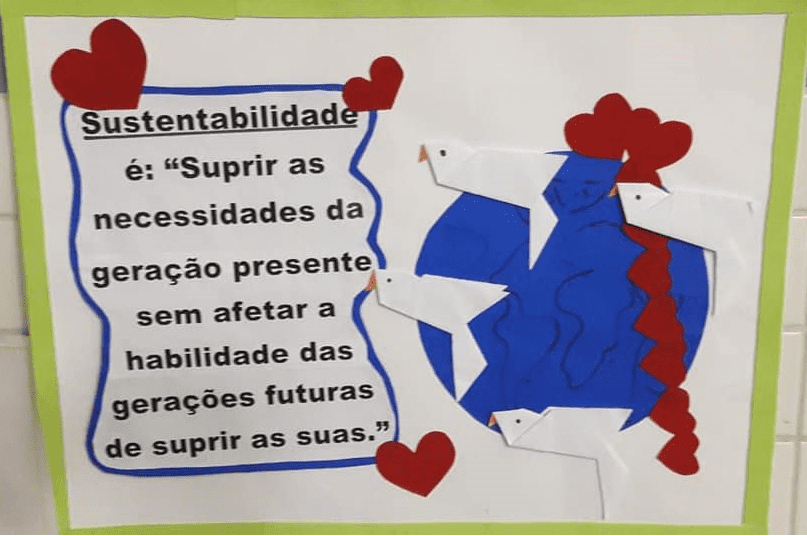
- Activity 4 – The students watched videos on the theme sustainability. Then space was opened for reflection and awareness. The following questions have been raised to provoke the consideration: What is my responsibility? What can I do to propagate sustainable practices in the environment in which I live? How to make a difference in a community? Do small sustainable practices elevae to large?
It should be emphasized that this was a relevant moment, because the students had the opportunity to make a parallel between a sustainable planet and a planet degraded by human actions.
- Activity 5 – Textual production on sustainability. After elaborating their own texts, the students read the texts of other students, so that all the works produced were shared. At that moment they were able to exercise and share ideas and arguments. Writing on the subject was a pedagogical strategy, and from it, it aimed to go beyond concrete life actions and favor more complex cognitive processes, because the creation of a manual requires more elaborate cognitive skills that enrich critical thinking and contribute to the acquisition of new knowledge. So they were able to replicate what they learned in class;
- Activity 6 – Class on tire reuse. In this activity, the production of handmade pieces using tires was proposed. After the production of the works, they became part of the entrance hall of the college. The school changed its landscape, through decorative pieces, elaborated through recycling. The objective was that these recommendations be introduced into the life of the entire school community, including the students’ relatives so that they could reflect on how to live sustainably, and thus contribute to the planet.
- Activity 7 – Discussion on incorrect disposal of cooking oil. In this activity, the following questions were pointed out: What consequences do they generate? What can be done to minimize impacts on the environment? How to reuse the oil?
Figure 2 – Tank for used cooking oil
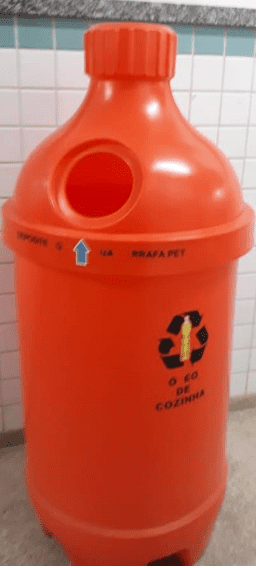
Then the production of bar soap was proposed, whose raw material is the cooking oil already used, will soon be reused. For this, a drum was made available by the Environment Department for students to deposit the pet bottles with cooking oil, which was brought from home. This action was difficult to accomplish, considering that the students could not perform without the support of a teacher, since it was an activity with caustic soda handling. However, it was a pleasurable activity, as all the students involved participated, contributing to the donation of used cooking oil.
Figure 3 – Recipe for bar soap
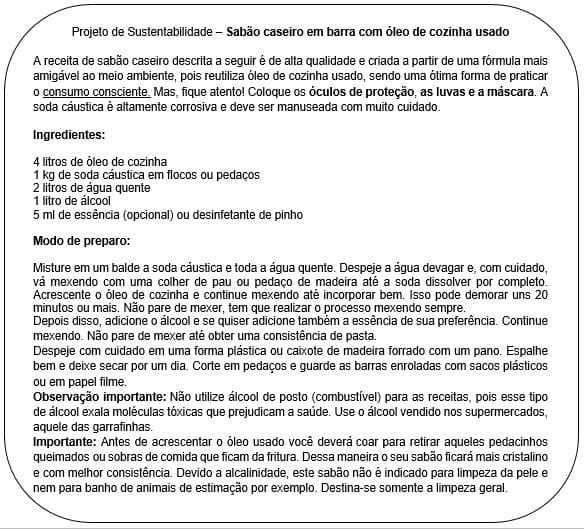
Finally, all the soap produced was distributed among students and family members. With this, in addition to acting in a sustainable and conscious manner, the students were encouraged to reflect on the incorrect disposal of contaminant residues from the environment that affect the ecosystem of soils, rivers and seas, reaching the groundwater, flora and fauna present in this route. This practice will cause consequences that directly affect human health and the imbalance of microorganisms, plants and animals, since cooking oil is formed by insoluble components and when subjected to disposal in the sewage network negatively affects, causing the decrease in oxygen that makes up the molecule H2O. With this, it affects the ecosystem globally. This problem was discussed with the students.
Figure 4 – Distribution of soap made with cooking oil
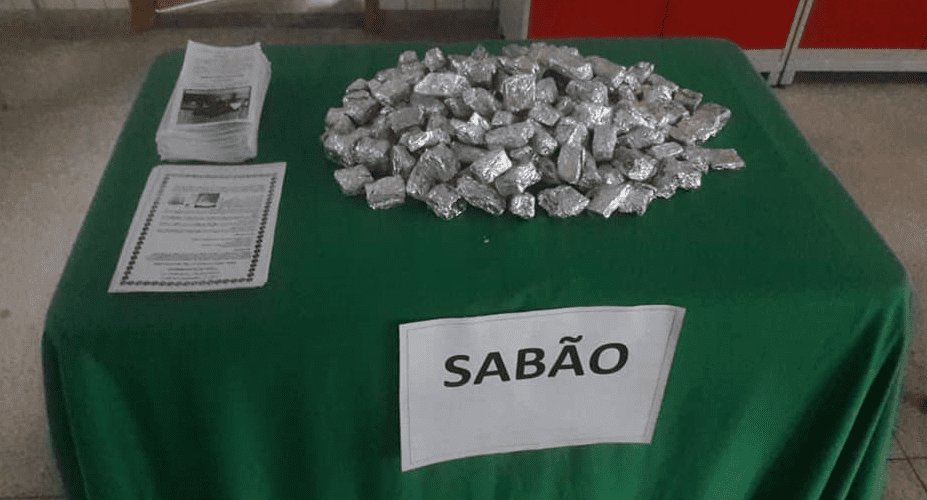
- Activity 8 – Lecture on sustainability. In this activity was also carried out the delivery of informative folder prepared together with students on sustainability and also the exposure of the activities developed.
This moment aimed to multiply the knowledge constructed and was relevant in order to disseminate in the community the elaborations of students and demonstrate the collective work, between teachers and students on the most appropriate ways to promote sustainable actions and projects in the context of the school.
Figure 5 – Folder on sustainability (front)
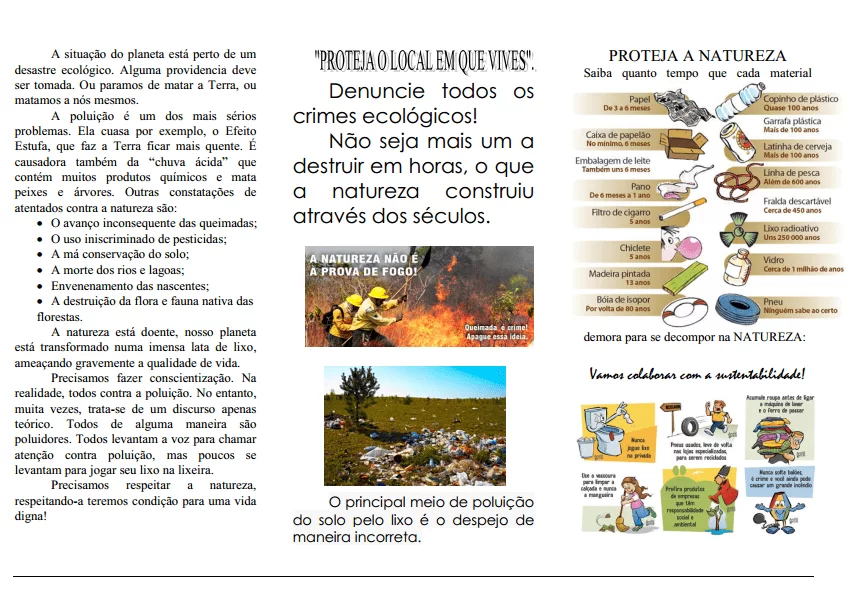
Figure 6 – Folder on sustainability (back)
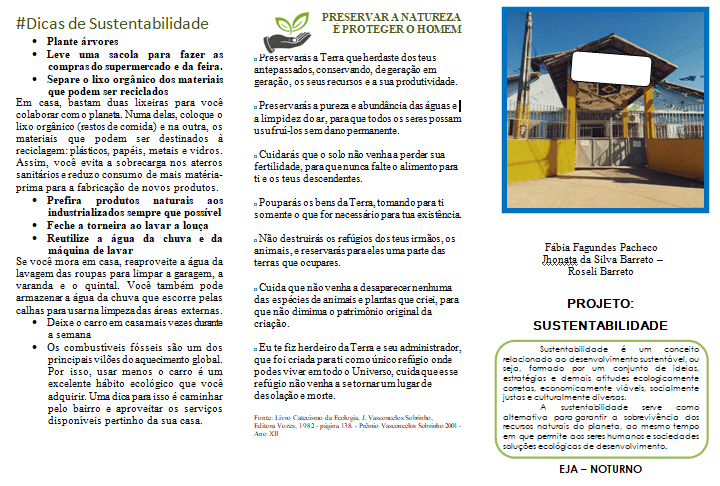
For there to be a really sustainable education, it is necessary that those involved propose to see the world from another perspective and through the word, as Paulo Freire (2001) states. Reading the world to better know it, better interpret it, making it closer to the human being is what makes it possible to act better in this. Reading the world to know its problems, but also its potentialities that can lead to changes for the better is a way to value and exploit it.
3. RESULTS
From the data presented, resulting from the articulation of an awareness project about the importance of sustainability in the context of the EJA, it can be highlighted that the motivations for its application occurred due to the need to make the students involved reflect on the sustainable actions and projects that are proposed on a daily basis, aiming at improving their level of awareness about the importance of sustainability , so that they could change their own behavior, both from individual and collective practices, through the knowledge studied. It was extremely important to realize the potential of each participant, when the group began to decide where to invest and charge more actions in relation to environmental preservation. The initial reflections on the theme also triggered clarifications about this concept.
When asked about the expression “sustainable development” and what the meaning of this term designates, 15% of the students pointed out the alternative “The interruption of economic practices to ensure the conservation of natural elements” and 85% of the students opted for the alternative “The maintenance of economic development in order to ensure the preservation of nature and natural resources for future generations”. It is noticed that the students showed concern about the environment. It was expressed that they emphasized the preservation of nature not only because it is the right one, but by virtue of future generations. It is also observed that they sought to defend the interests of the present moment, however, aiming at practices that will reflect in the future. In this sense, Silva (2018, p. 17) explains that
Whatever you do and decide should always ensure that your decisions have a significant impact on both social responsibility and the sustainability of community-impact decisions.
This percentage of 85% denotes that these students know significantly the ideas that desepar from the concept of sustainable development. The question considers the need to acquire awareness and the unso sustained pattern of consumption of current societies has given rise to a great concern about the depletion of natural resources, producing the following results: 8.5% of the students opined that society practices an alienating consumption; while 17.5% believe that consumption is a planned obsolescence and 74% of students stated that it is only through an ecological awareness that a sustainable pattern of survival will be achieved.
This percentage (71%) of demonstrations indicates that most students consider it important that we all change our practices for sustainable living. According to Rodrigues and Tristão (2011) it is necessary to combat waste. Therefore, rethinking the pattern of unso sustainable consumption is crucial, in order to promote subjective transformations that will have repercussions, in the long term, on changes in cultural patterns. Faced with this problem, that is, due to the environmental devastation that was born and established with the process of industrial development, most respondents pointed out that they would start a process of change through daily actions, such as collective defense. This occurred when they began to desire changes in common habits, for the welfare of all.
Thus, it is perceived that this attitude was born due to knowledge about sustainable development from the proposed pedagogical activities. It is noteworthy that although it is a slow change, because the education process is slow and needs to be continuous, it is essential. The use of the expression “sustainable development” for 35% of the students collaborating with the project should be used to refer to the need to sustain the environment in the development process, so that natural resources do not end and that other environmental problems can be mitigated. However, 65% said that it is interesting that there should be a reconciliation between development and environment. It is perceived that students argue that environmental awareness is essential in this process of searching for a sustainable environment.
Table 1 – Purpose of the term sustainable development
| Purpose in % | |
| Sustaining the environment to the detriment of development | 35% |
| Propose the reconciliation of development with the environment | 65% |
Source: Prepared by the author (2020)
Sustainability aims to support socioeconomic development in a more ecological way, that is, in line with the demands of the environment itself. Therefore, the main challenge is not to compromise the capacity of this medium to meet the needs of future generations. From this approach it was questioned what possible individual attitudes they would adopt to promote sustainable development. Of the participants, 87% would avoid unnecessary consumption. Already 2% would buy what is fashionable and discard anyway what is no longer used; while 83% would adopt the attitude of avoiding water waste.
A percentage of 63% also pointed out that adherence to biodegradable materials, on the other hand, another 33% indicated that they would adopt only disposable products, because they understand this a viable alternative within their life context. On the other hand, the option of using natural lighting or low-consumption lamps was selected by 61% of those involved. For those who have indicated this option, it is essential to replace the lamps. The research also pointed out that 11% of the collaborators with the study emphasized that it is necessary to worry about the environment in daily life.
Table 2 – Actions for sustainable development
| Mark with an X possible individual attitudes to promote sustainable development | ||
| Answer options | Quantitative | Percentage |
| Avoid unnecessary consumerism; | 40 | 87% |
| Buy what is fashionable and discard anyway what is no longer used; | 01 | 2% |
| Decrease water waste; | 38 | 83% |
| Purchase biodegradable products; | 29 | 63% |
| Avoid disposable products; | 15 | 33% |
| Use of natural lighting or low consumption lamps; | 28 | 61% |
| Don’t worry about environmental awareness in your social cycle. | 05 | 11% |
Source: Prepared by the author (2020)
The students were asked about which modes of uses and customs human activities interfere in the water cycle. For this problem, 13% answered that human activity interferes “in the total quantity, thus altering quality”. However, for 80% of students it only changes “the quality of the water that is available for the consumption of populations”. Among the participants, three did not position themselves before the question, corresponding to 7% of the group. In view of this problem, it was expressed that the form of water consumption affects the water cycle. Thus, they emphasize that when there is uncontrolled use, the environment is compromised, because one lives in an unbalanced situation. Therefore, being aware of one’s own actions is the beginning to adopt changes in habit and attitude.
Table 3 – Human activities and interference in the water cycle
| Interferes with the water cycle (%) | |
| The total quantity | 13% |
| The amount of water available for the consumption of populations | 80% |
| They did not position themselves | 7% |
Source: Prepared by the author (2020)
The students were urged to give their opinion on the term “recycling” and whether the following placement is false or true: “The idea of recycling should be encouraged because it is an important way of preserving the environment.” In view of this conception, the students opined in favor of recycling. It starts from the notion that with recycling the environment is less impaired, because it reduces the pollution brought by landfills (reducing the amount of waste) and saves natural resources, such as trees (used to make paper), oil (raw material for plastic) and ores (from which metals can be obtained).
Thus, 04% of the students answered false, because, for them, recycling does not favor environmental preservation and it is appropriate not to pollute. 85% consider the statement true and that recycling is essential for living more sustainably and for resources to be preserved for future generations. In this question, five (5) students did not score any option, corresponding to 11% of the participants. According to these non-respondent students, the question is unfeasible, within their context, because they have difficulties, in their routine, to practice recycling.
Table 4 – The importance of recycling
| Recycling should be encouraged (%) | |
| Fake | 04% |
| True | 85% |
| They did not give their opinions | 11% |
Source: Prepared by the author (2020)
After questioning and inferences of students about recycling, another problem was elucidated: if they usually reuse some type of material that goes to waste. Each student marked the option that he considered pertinent to the reality itself; considering the daily actions themselves, the result of which is summarized in Chart 5.
Table 5 – Reuse of products that can be recyclable
| Do you usually reuse some kind of material that goes to waste? Check the option that suits you. | ||
| Answer options | Quantitative | Percentage |
| A) No, because I do not know how to reuse materials. | 6 | 13% |
| B) No, because garbage is to be thrown in the trash. | 4 | 9% |
| C) Yes, I turn shoe boxes into gift packs or use them to store other objects; | 10 | 22% |
| D) Yes, I use pet bottles to store oil I no longer use, or other materials; | 14 | 30% |
| E) Yes, I use the bags that used to go to the trash to shop; | 12 | 26% |
Source: Prepared by the author (2020)
Regarding the chart that is on display, in which the students demonstrated which materials they reuse in order not to go to waste, option A (which corresponded to 13% of the total) is very worrying, since this percentage reveals a considerable amount. Not knowing how to reuse garbage is a worrying situation. Thus, it was perceived the importance of continuing actions aimed at raising awareness to minimize this worrying result. The students reused several subjects. The following figure is an art with tires that they produced.
Figure 7 – Art from tires
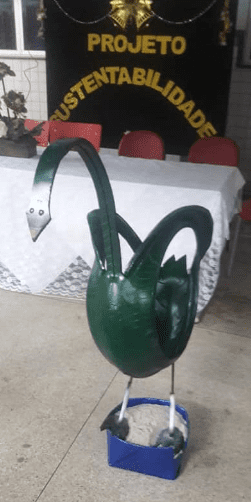
In addition to what can be affirmed with this text, something better is expected to achieve, for example, such as: changes in values, conscious actions and demands of society for the incorporation of sustainable actions. Thus, it is expected to seek, therefore, a culture with a network of meanings that will lead to effective sustainable practices in the routine of these students. Through the questionnaire applied to the students, information was collected about the knowledge that the students of the EJA carried and the degree of interest of them about sustainability, and thus it was remarkable that they are s working to change their habits. At the end of the work, an exhibition was held with demonstration of the use of recyclable materials and lectures to alert everyone. Thus, it was possible to make their interest in the theme become greater.
FINAL CONSIDERATIONS
The importance of having a broad understanding of sustainability was evidenced, considering the principle that it involves, both its mental, physical, spiritual and social aspects. They can serve as a starting point, especially with regard to the effects and consequences in the different environments: familiar, social and organizational. The theme was articulated in the context of the school, due to the intimate relationship between environment and learning. The students understood that they can translate the theme into actions, as well as apply it from sustainable actions in all social contexts. The collected data allowed us to understand the theme through a scientific perspective instead of mere ideology, since the students’ position was in line with the sustainability theme.
Environmental sustainability is associated with the use of renewable resources and communication and interaction with others foster the triggering of greener practices. Thus, the school needs to provide this connection between EJA students and sustainability more frequently, so that sustainable habits are incorporated into life and are part of the culture of students. Thus, the school should create mechanisms to allow them to review their practices, and thus rethink the different dimensions of sustainable development so that new motivations for the care of natural resources arise. Providing the other with the right to care for, care for and protect the planet requires attitude and conscience. Thus, the environmental problems caused by human beings can be reduced and society will have the chance to take on new positions, in line with sustainable responsibility.
REFERENCES
ALMEIDA, F. The challenges of sustainability an urgent break. 15th ed. Rio de Janeiro: Elsevier, 2007.
Brazil. Constitution (1988). Constitution of the Federative Republic of Brazil. Organization of Alexandre de Moraes. 16th ed. São Paulo: Atlas, 2014.
Brazil. Ministry of education. National Curriculum Parameters: Elementary School. Brasilia: MEC/SEF, 2000.
DIAS, R. Environmental management: social responsibility and sustainability. 3rd ed. São Paulo: Nova Cultura, v.1, t.1, 2006.
FREIRE, P. Pedagogy of autonomy: knowledge necessary for educational practice. 20th ed. São Paulo: Editora Paz e Terra S/A, 2001.
JACOBI, P. Environmental education, citizenship and sustainability. Research Notebooks, n. 118, p. 189-206, 2003.
LEONARDI, M.L.A. (2009). Environmental Education as instruments to overcome the unsustainability of today’s society. IN: LEONARDI, M. L. A. Environment, sustainable development and public policies. São Paulo: Cortez: Recife: João Nabuco Foundation, 1997.
LIMA, G. da. C. The discourse of sustainability and its implications for education. Environment & Society, v. 6, n. 2, p. 99-119, 2003.
MARX, K. Capital: critical of political economy. Translation by Regis Barbosa. São Paulo: Atlas, 1988.
MUNHOZ, T. Sustainable Development and Environmental Education. In: Environmental Education, 2004.
RODRIGUES, F. F. R.; TRISTAN, M. Sustainable School and Environmental Education: the knowledge of a community in the formation of the culture of sustainability. 2011. Available in: https://mail.google.com/mail/u/0/?tab=wm&ogbl#inbox?projector=1. Accessed on: 12 Feb. 2020.
SANTOS, M. C. dos. Sustainable development: critical-scientific interpretations. 2011. 61 f. Specialization (Environmental Analysis and Education in Earth Sciences) – State University of Londrina, Londrina, 2011.
SILVA, H.L. da. Responsibility and ethics. 2nd ed. Curitiba: Fael, 2008.
TRISTAN, M. Environmental Education in teacher training: networks of knowledge. São Paulo: Annablume, 2004. 236p.
TRISTAN, M. Environmental education and formative contexts: an interpretation of movements in the paradigmatic transition. Research notebooks in Education, v. 14, p. 122-148, 2008.
TRISTAN, M. Environmental Education and the paradigm of sustainability in times of globalization. In: WAR, A.F.; FIGUEIREDO, M. L. (Org.). Sustainability in dialogue. Itajai-SC: Univali Publishing House, 2010, v. 1, p. 157-172.
UNESCO. United Nations Decade of Education for Sustainable Development, 2005-2014: final document of the international implementation scheme. Brasilia: UNESCO, 2005. 120p.
[1] Master’s degree in Science, Technology and Education, from Vale do Cricaré São Mateus College.
[1][2] Master’s degree in Science, Technology and Education, from Vale do Cricaré São Mateus College.
[3] Specialization in Integrated Educational Management. Specialization in Environmental Education. Graduation in Pedagogy. Graduation in Science – Biology Qualification.
[4] Specialization in Inclusive Special Education. Specialization in Mathematics Teaching Methodology. Specialization in Integrated Educational Management: Administration, Guidance, Guidance and Inspection. Specialization in Supervision and Pedagogical Coordination. Graduation in Pedagogy Degree. Graduation in mathematics.
[5] PhD in Environmental Education – Professor of the Master’s Program of Vale do Cricaré College.
[6] Master in Environmental Technology – Professor of the Master’s Program of Vale do Cricaré College.
Sent: April, 2020.
Approved: May, 2020.















